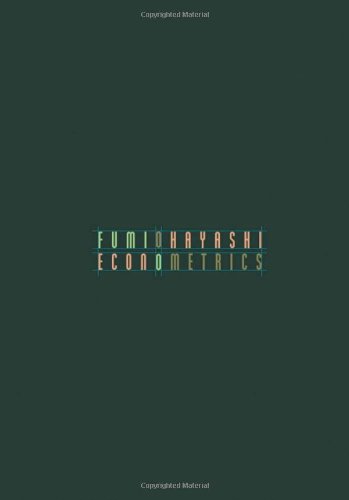Econometrics
<Test>
Yi-Hsi Lee
Econometric Books
-
Books Review (Amazon)
- Textbook:
- Gujarati and Porter (2008), Basic Econometrics.
- References:
- Hayashi (2000), Econometrics.
- ...


Gujarati and Porter (2008)
-
Introduction
-
PART ONE Single-Equation Regression Models
- 1 The Nature of Regression Analysis
- 2 Two-Variable Regression Analysis: Some Basic Ideas
- 3 Two-Variable Regression Model: The Problem of Estimation
- 4 Classical Normal Linear Regression Model (CNLRM)
- 5 Two-Variable Regression: Interval Estimation and Hypothesis Testing
- 6 Extensions of the Two-Variable Linear Regression Model
- 7 Multiple Regression Analysis: The Problem of Estimation
- 8 Multiple Regression Analysis: The Problem of Inference
- 9 Dummy Variable Regression Models
GUJARATI AND PORTER (2008)
-
PART TWO Relaxing the Assumptions of the Classical Model
- 10 Multicollinearity
- 11 Heteroscedasticity
- 12 Autocorrelation
- 13 Econometric Modeling: Model Specification and Diagnostic Testing
Chapter I: Introduction
1.1 What is Eocnometrics?
1.2 Why a Separate Discipline?
1.3 Methodology of Econometrics
1.4 Types of Econometrics
1.5 Matheatical and Statistical Peerequisties
GUJARATI AND PORTER (2008)
- 14 Nonlinear Regression Models
- 15 Qualitative Response Regression Models
- 16 Panel Data Regression Models
- 17 Dynamic Econometric Models: Autoregressive and Distributed-Lag Models
GUJARATI AND PORTER (2008)
- 18 Simultaneous-Equation Models
- 19 The Identification Problem
- 20 Simultaneous-Equation Methods
- 21 Time Series Econometrics: Some Basic Concepts
- 22 Time Series Econometrics: Forecasting
GUJARATI AND PORTER (2008)
- A A Review of Some Statistical Concepts
- B Rudiments of Matrix Algebra
- C The Matrix Approach to Linear Regression Model
- D Statistical Tables
- E Computer Output of EViews, MINITAB, Excel, and STATA
- F Economic Data on the World Wide Web
1.1 What is Econometrics?
Econometrics = Economic Measurement
1.2 Why a Separate Discipline?
-
Economic Theory
-
Mathematical Economics
-
Economic Statistics
-
Mathematical Statistics
Experimental Data vs Observational Data
Q? Experimental Economics / Behavioral Finance
Anatomy of econometric modeling
1.3 Methodology of Econometrics (Classical vs Bayesian)
-
Statement of Theory or Hypothesis
-
Specification of the Mathematical Model of the Theory
-
Specification of the Statistical, or Econometric, Model
-
Obtaining the Data
-
Estimation of the Parameters of the Econometric Model
-
Hypothesis Testing
-
Forecasting or Prediction
-
Using the Model for Control or Policy Purposes
Kaynes's MPC Model (Marginal Propensity to Consume)
1. Statement of Theory or Hypothesis
Keynes stated:
The fundamental psychological law . . . is that men [women] are disposed, as a rule and on average, to increase their consumption as their income increases, but not as much as the increase in their income.
In short, Keynes postulated that the marginal propensity to consume (MPC), the rate of change of consumption for a unit (say, a dollar) change in income, is greater than zero but less than 1.
Note: Chossing among (between) Competing Models
ex. Hall's Life-cycle Permanent Income Hypthesis
2. Specification of the Mathematical Model of the Theory
3. Specification of the Statistical, or Econometric, Model
4. Obtaining the Data
Proxy Variables: Y->PCE; X->GDP
5. Estimation of the Parameters of the Econometric Model
6. Hypothesis Testing
7. Forecasting or Prediction
8. Using the Model for Control or Policy Purposes
Control Variable: X
Target Variable: Y
1.4 Types of Econometrics
1.5 Mathematical and Statistical prerquisties
- Appendix A: Basic Statistical Concepts
- Appendix B: Matrix Algebra
- Appendix C: Basic Regression Theory in Matrix Notation
1.6 The Role of the Computer
-
EVIEWS
- LIMEDEP
- SCA
- STATA
- R
- SAS
- SPSS
- ....
Types of Econoometrics?
- Macroeconometrics
- Microeconometrics
- Financial Econometrics
1.7 Types of Data
- Time Series Data
- Cross-sectional Data
- Pooled Data
- Panel / Longitudinal / Micropanel Data
The Sources of Data
- TEJ
- CMoney
- AREMOS
- Datastream
- Computstat
- BankScope
- ...